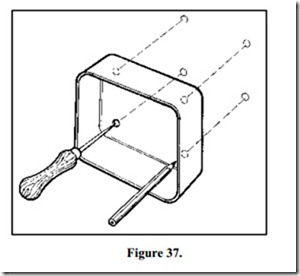Method of Fixing into Wood
First decide on the position of fixtures. Then take measurements off the walls, ceiling or floor. Use the same base line (datum line) each time. For repetitive fixing, a measuring rod may be more efficient. Using the fixture itself, or a template, clearly mark out the position of the holes using a pencil or a bradawl as shown in Figure 37.
Make a hole in the wood, for one woodscrew, using the bradawl. The hole should be about half the depth by which the woodscrew must enter the wood. As a general guide the woodscrew should enter the wood a distance equal to 5 times its thread diameter. Select the correct type and size of woodscrew. Note the surface finish on the fixture at the fixing point. Where a recess is provided, use a countersunk screw, if not use a round head screw. Check the diameter of the hole in the fixture and select a screw having a diameter equal to or slightly less than this. Drive the woodscrew into the prepared hole (preferably an uppermost hole) and allow the fixture to hang from this screw. The fixture can now be aligned accurately. Each remaining hole can be checked and started using the bradawl. The screws can be inserted and driven home. Finally tighten the first screw and check that the fixture is secure.
N.B. Do not overtighten screws particularly when securing hard plastics as these may crack easily.
When driving screws into hard woods it is advisable to drill a pilot hole which should be 2 mm less than the diameter of the screw thread.
Related posts:
CONTROL FUNDAMENTALS:COOLING GENERAL
FUNDAMENTALS OF ELECTRIC SYSTEMS:ALTERNATING CURRENT
Stepping Servo Motors:Dynamic Response Characteristic over One Step Movement
INTERLOCKING MOTORS
Single-phase motors:Shaded-pole Single-phase Motor
Electric Motor Manual – INSTALLATION METHODS - Grounding motors effectively
Overload relays:Thermal Overload Relays
Repulsion-Type Motors
Binary number System:Bcd code
Constant-Horsepower Connection
ELECTRONIC CONCEPTS AND MORE INTERESTING THAN YOU THINK:MAGNETISM
DC Hipot Test
Light and associated radiation:Photoresistors and photoconductors
CONVENTIONAL D.C. MOTORS:TORQUE PRODUCTION
